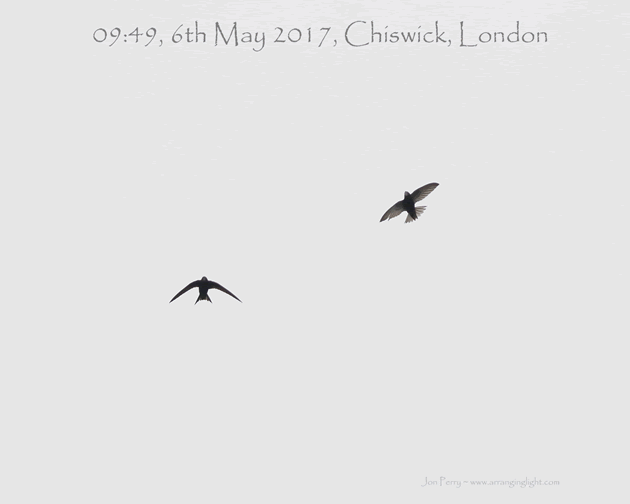Swifts Have Arrived Back in Chiswick
Only a few colonies of this migratory bird left in the area

Image by Jon Perry
|
Our first Chiswick swifts have arrived! Right on cue – 6 May – six swifts are here this morning, zipping around the sky above St Alban’s Avenue and South Parade, with two seen whizzing straight down the street.
These amazing small migratory birds, the weight of five of the new pound coins, have flown 7,000 miles from their wintering areas above central and southern Africa, and have just completed the last stage from the skies over the southern part of West Africa in just a few days in their rush to get home.
Although swifts spend nine months of their lives on migration and wintering over Africa, we can truly say that home is here. Each pair is speeding to its own ‘front door’ – a small opening to its
own nest in a small space in our eaves or in crannies high up in buildings. Swifts pair for life and keep their exact same nest for life. The first thing they’ll do after nine months constantly on the wing is to have a good sleep in their own nest. They will wait for their partner to arrive before the female lays eggs and the pair raises a small family of two or three swiftlets.
Chiswick resident and RSPB Swift Volunteer, Catherine Day, set up the Chiswick Swift Project two years ago to try and save our few remaining swift colonies in Chiswick (which may sadly now consist of only a few individuals) and to turn things around to achieve a measure of species recovery here.
Swifts used to be a familiar summer sight in Chiswick zipping through the air in summer, but we have unwittingly removed or blocked up their decades-old nesting sites through our roof repairs and loft conversions, combined with today’s new building methods and new building materials. They are now an Amber-listed Species of Conservation Concern in the UK.
The thrill of watching the aerobatics of these ‘mini-red arrows’ of the avian world is something that we could all share again very easily: we need to provide them with new homes by putting up swift nest boxes or including ‘swift bricks’ (virtually invisible nest boxes made to look like bricks) when doing building works.
Most importantly, right now, our swifts are arriving and Catherine would like everyone in Chiswick to look out for, and enjoy watching, these incredible birds. Swifts lead the most aerial existence of any bird species and are the world’s fastest bird in level flight.
How do you identify a swift?
Most distinctive are its very long, pointed, swept-back, scythe-shaped wings; its fast, stiff-winged, rather flickering flight; and its speed and superb aerodynamics as it hunts midges, mosquitos and tiny airborne spiders and other insects. You may pick up its high-up, high-pitched, excited screaming call before you see them.
Swifts are all dark brown (but look black in the sky), and have a very small white-ish patch under their chins (usually invisible to the naked eye). Swifts land only when they fly in to their high-up nest places, out of sight, so you will never see one perched or on the ground.
Watch this space for more about our Chiswick swifts. Catherine will be keeping us posted on their three short summer months with us.
May 6, 2017